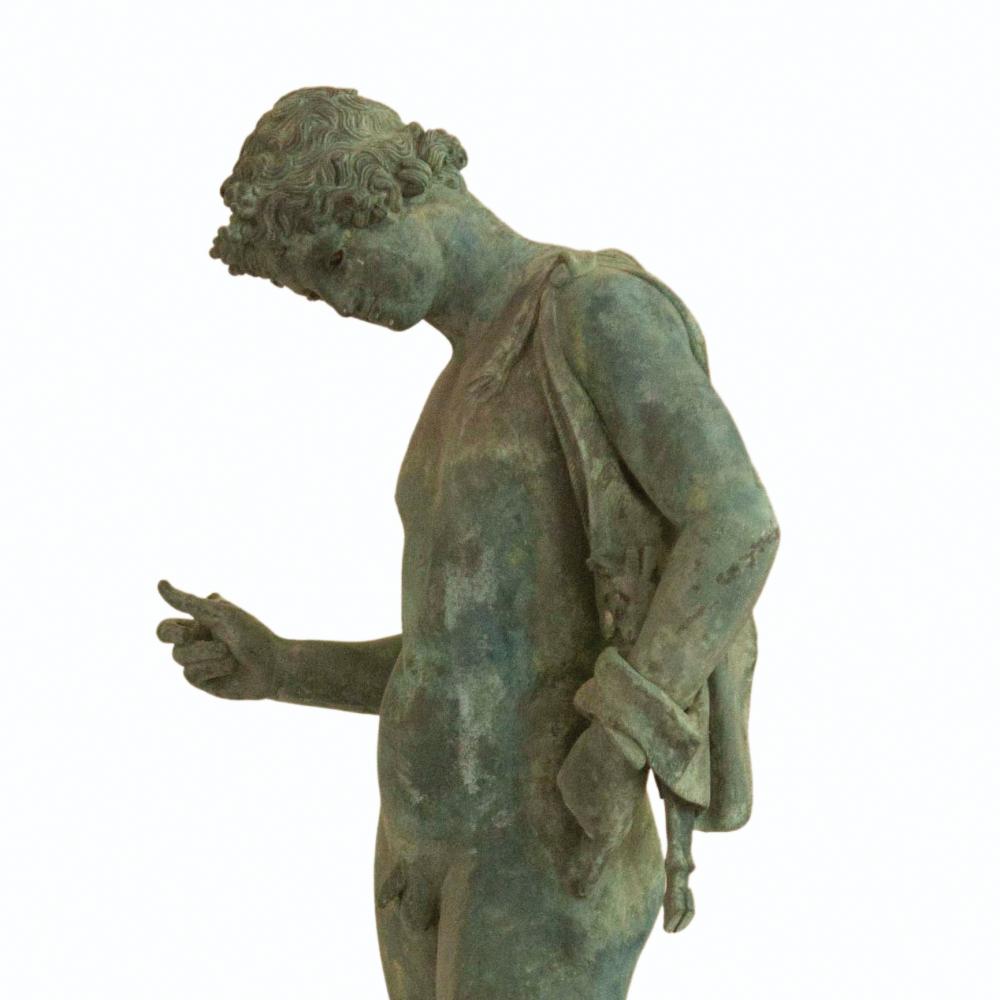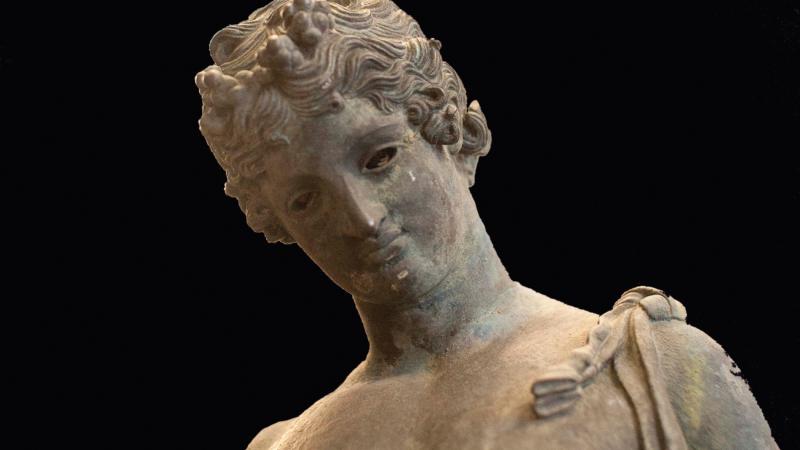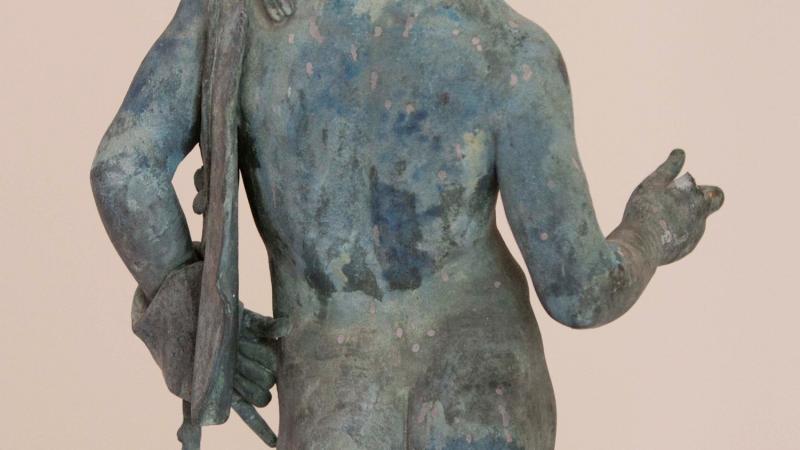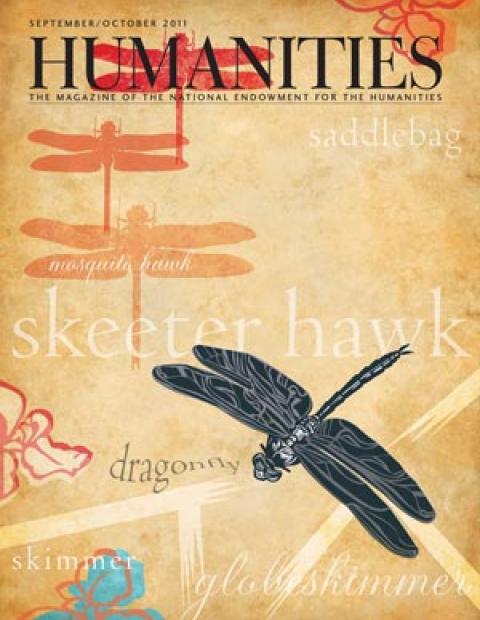A few years ago, I was poking around in our university archives, when I happened to spot a small classical statue with a lovely green patina in a glass case by the back wall. “What’s that?” I asked, and was told it was a nineteenth-century replica of an ancient original, and that it once belonged to Tennessee Williams. The statue, a bronze male nude, had come to the archives as part of the playwright’s estate, and had been sitting in the case, unnoticed, for well over a decade. Though I didn’t realize it, this marked the beginning of an investigation that led, along a roundabout path, to some unexpected discoveries about Williams’s work and life.
First, some background. I am the chair of Classical Languages here at the University of the South, which most people call Sewanee, the name of the town in rural Tennessee where the school is located. The university is made up of a small liberal arts college and an Episcopal seminary, and is the only university in the country still to maintain a formal connection with the church. As I already knew before my chance encounter with his little statue, Tennessee Williams had named Sewanee as the sole beneficiary of his literary estate upon the death of his sister, Rose. Although Williams had no substantial connection to Sewanee, his beloved grandfather, Walter Dakin, had gone to seminary here and always spoken fondly of it. Since Rose’s death in the 1990s, the royalties from the plays have come to Sewanee and have been used to sponsor the annual Tennessee Williams fellowship for a playwright-in-residence and to fund the Sewanee Writers’ Conference every summer.
What I did not know was the story of the somewhat more diffuse distribution of Williams’s personal effects. His papers went largely to Harvard, but the rest of the playwright’s estate, after being cataloged by Christie’s, was shipped to a warehouse in New Jersey, where it sat for some time until an arrangement was made with Columbia University to house a portion of it. This spring, in fact, Columbia had many of these objects on display in an exhibition called “This Is: Tennessee Williams & Friends,” in celebration of Williams’s centennial year. The remaining items, I came to learn, had somehow made their way to Sewanee, including Williams’s patio furniture, his breakfast plates, his toaster, which still works (don’t ask), and, of course, the statuette I chanced upon in our archives.
Statuette Comes to Class
As I looked at the little nude that afternoon, I thought to myself that he could just as easily be gathering dust in the seminar room where I teach, so I arranged for his relocation. Perched on a plinth in the corner of my classroom, the statuette has lent to my lessons of Latin grammar a certain air of classical authenticity. Although a replica, the century-old statue is the same size and made of the same material as the ancient original excavated from Pompeii. Who is depicted, if anybody, is unclear. The figure’s downward gaze led art historians initially to conclude that he must be Narcissus, staring intently at himself while listening to the distant song of Echo. The goatskin draped over his left shoulder, however, together with the ivy and grape clusters gathered at his brow, have led others to identify the figure with Dionysus, as these are often associated with the deity. To yet others, he is simply an ephebe, a young man at the height of his adolescent beauty.
But whether it represents the self-absorbed youth or the bacchanalian god, the original has been considered a masterpiece since the time of its discovery, when it was praised as being “unique par sa merveilleuse beauté.” Of the many bronzes unearthed from Pompeii and displayed in the Naples National Archaeological Museum, this figure was long thought the collection’s “pearl.” With a dainty elegance bordering on effeminacy, the figure does not look the part of a traditional Greco-Roman hero. While perhaps not to contemporary taste, the young man shows the influence of Praxiteles, the Greek sculptor of the fourth century BCE, whose trademark style was a lithe and sinuous eroticism.
Nude but for his elaborate sandals, the statue stands contrapposto, his firmly straightened right leg causing the left leg to rise and hips to tilt forward. As if to emphasize the artificiality of the pose, his hand rests with mannered delicacy on his left hip while the goatskin hangs daintily from his shoulder. His right hand is raised with forefinger extended—though, alas, this finger is missing on Williams’s copy—giving the impression of detachment, as though the figure’s attention were not with the viewer but focused elsewhere.
The figure’s material and size—the statue stands just over two feet high—helped make replicas attractive to travelers on the Grand Tour. Widely copied throughout the later nineteenth and early twentieth centuries, the little Dionysus was thought to be just the thing for the garden or drawing room. In fact, Oscar Wilde, whose London home was filled with classical statuary, displayed a copy prominently on his mantelpiece. In the back pages of Baedeker’s Italy from the Alps to Naples, the author recommends not only the best places to rent boats and obtain cigars, but also where to purchase reproductions of antique bronzes.
Singled out for its “high reputation” was the foundry of Gennaro Chiurazzi on the Via Calabritto, not far from the museum. “The green bronzes are cheaper than the copper-coloured,” Baedeker observed helpfully, giving what he deemed to be fair prices. Williams’s Dionysus comes from the Chiurazzi establishment, as can be made out from the foundry mark on the stand by Dionysus’ right heel. It reads “Naples” in English rather than “Napoli” in Italian, a sure sign of its being made for the tourist market. The Chiurazzi foundry continued to produce such works right up to the Second World War, when any and all such metalworking was turned to purposes darker in nature.
One day last year, while my intermediate Latin students were taking a quiz, I was looking at the statue and wondering what the statue might have meant to the playwright. Williams’s hundredth birthday was coming up at the end of March, and it occurred to me that perhaps the figure’s refined, coy pose had some connection with larger themes in his work. So, I gathered some colleagues and students to investigate the matter, and, as it turned out, there was a lot to learn. Over the next few weeks, we looked into it, meeting for lunch to share what we had found. Much of what I know now about our ephebe I owe to their enthusiastic investigations.
Surprising Poetic Discovery
Williams is one of the South’s preeminent authors, of course, but he also had a lifelong love affair with Italy and spent much time there. With a little digging through his letters and journals, it did not take our little research group long to come across this passage in a letter from Williams to his friend, Oliver Evans, from early February 1948: “Dear Oliver, I have just returned from a trip through Southern Italy, first to Sicily to watch the making of an Italian film. . . . Then I went to Naples. I think you would be disappointed in it now. Conditions are frightening, half the population or more living in destitution and bordering on violence. I got some nice little art-objects there, including a copper statue of a boy in Pompeii, which I wrote a poem about.” Enclosed with the letter was a typescript of the poem, entitled “Testa dell’Efebo” (“Head of the Ephebe”), which Williams would publish in revised form later that year in Harper’s Bazaar.
What is immediately striking to any reader about “Testa dell’Efebo” is its complexity. In its form, the poem has a sustained, one might even say rigid, formality, with four stanzas consisting of four lines of iambic tetrameter apiece. And yet the formalism of the poem is not especially helpful in uncovering its meaning, even after careful rereading. The young man’s head (for which the poem is named) is turned away from us, and a similar obliqueness in the poem is apparently Williams’s intention. A sort of preoccupation characterizes the poem; it simply does not seem interested in explaining itself to us. In this way, it closely resembles the statue of the distracted figure that inspired it.
“Testa dell’Efebo” is an ekphrasis, a poem that describes a visual work of art. It is a well-established genre that ranges as far back as Homer’s representation of Achilles’ shield in the Iliad, and has given us powerful examples in English too, such as Robert Lowell’s portrait of the Shaw Monument on the Boston Common in “For the Union Dead.” In this instance, though, one senses a great debt on Williams’s part to “Ode on a Grecian Urn,” and to Keats more generally. Indeed, “Of Flora,” the curious opening words of “Testa dell’Efebo,” is a quotation from Keats’s “Ode to a Nightingale,” a tribute to the power of music even as “Ode on a Grecian Urn” is a tribute to the power of classical sculpture.
Williams begins by reflecting on the statue’s physical production through the ancient “lost wax” method: The verse “trembling shells were struck and held” refers to the way that molds were made around statues and then removed so that they could be refilled with molten bronze for the making of copies. It is a method of manufacture that was used by ancient foundries as well as by the Chiurazzi foundry of Naples for the sake of authenticity. Bronze or copper statues made in such a manner do have a bright golden appearance at first, though after some time they lose their sheen. “How thinly gold his shoulder gleamed,” Williams writes, in full awareness of the evanescent beauty even a sculpture possesses. It marks a departure from Keats, for whom the figures of the Grecian urn “cannot fade” and are forever “fair.” In all of this, Williams is keen to capture the Praxitelean quality of the statue, and there is a palpable though hard-to-pinpoint erotic element throughout the opening stanzas, which both the attention to the boy’s physical beauty and words like “gushing” and “trembling” all seem to imply.
But if Eros is important to the poem, so is Thanatos. Unlike the sightseers of the Grand Tour for whom the Chiurazzi foundry had originally made their bronze copies, Williams had come to Naples as a city utterly devastated by war. Many of the buildings Victorians had earlier come to admire lay in rubble in the streets, the victims of both Allied and Axis bombing. In another way, the wide-scale destruction of war was on Williams’s mind at the time: Asked by a writer for the Saturday Review about his current reading, Williams mentioned, in addition to works by Sartre and Camus, Selig Hecht’s Explaining the Atom, a best-selling account of the nuclear physics behind the A-bomb.
It does not seem too much to suggest that the clouds that “break in fire as glasses break” in the difficult third stanza are meant to call to mind the mushroom clouds over Japan only a few years before. And yet if Hiroshima is somewhere in Williams’s mind in “Testa dell’Efebo,” as well as war-torn Naples, so too he thinks of Pompeii, the great doomed city over which hovered a cloud of another sort. “And that town burned wherein was turned / This slender copper cast of him,” the poem concludes, with a haunting but not hopeless lyricism. Despite the devastation of Pompeii by Vesuvius, he seems to say, this tender statue of a charming young man has somehow managed to emerge, the survival of art in the face of annihilation, a victory for Creation against Destruction.
So, this was the poem for which my little statue served as muse. Not long after reading it for the first time, I got online and ordered a copy from eBay of the August 1948 issue of Harper’s Bazaar in which it first appeared. And there it was, this short but formal rumination on the short-lived and yet longlasting nature of beauty, sitting a little ironically among the advertisements and articles on what the fashionable college woman was wearing that fall. (Tweed, as it happens.) The poem was republished a few times, and was even set to music by Williams’s good friend Paul Bowles, although the song does not seem to have been recorded. Beyond all this, however, “Testa dell’Efebo” had subsequently dropped off into obscurity.
Only "Fully Realized" Work
Williams did not forget the poem, however. One day at lunch this spring, while my colleagues and I were talking about our project, one of the students remarked casually that she had come across a reference to the poem in People magazine. This seemed too surreal to be true, and yet, sure enough, there it was, in the May 26, 1975, issue, a profile by Jed Horne called “A Playwright Lives His Greatest Drama: The Resurrection of Tennessee Williams.” Horne had visited with Williams at home in Key West and had a long and rambling discussion with him. Toward the end of the piece, Horne wrote, “He says that his only fully realized work is not Menagerie or Streetcar or any of the other celebrated plays but a short poem he wrote years ago, called ‘Testa dell’Efebo.’”
This took us aback. That the statue hidden away in the archive had belonged to one of America’s greatest playwrights seemed surprising. That Williams should have written a poem about the statue seemed a bit of good fortune. But to find that he considered that poem “his only fully realized work” was positively uncanny, and all the more so when we realized that we had been discussing the matter during the weeks leading up to Williams’s hundredth birthday.
“Well that, indeed, is a blast from the past!” Horne responded when I found his website and e-mailed him. In 1976, Horne had been in his twenties, and would leave the newly formed magazine shortly afterward to go on to an impressive career as a journalist in New Orleans. While he thanked me for reminding him of the piece, he could not remember the stray remark at all, and was certain the notebook in which he had taken notes was moldering away in a landfill somewhere.
It seems only right that this poem, first published in the glossy pages of Harper’s Bazaar, should come up again in the glossy pages of People magazine, among so many bright and shiny celebrities who are now all but forgotten. In Horne’s well-written piece, Williams ponders the vagaries of success. His last unqualified hit, Cat on a Hot Tin Roof, had appeared on Broadway two decades earlier, and while revivals of his plays were numerous, the theater-going public showed less interest in his later works. And in a few years he would be dead. It is hard not to see Williams’s reference to “Testa dell’Efebo” here in connection with the decline in recognition that had been weighing on him late in his career.
Williams remained prolific to the end, though his work no longer commanded attention. Times and taste had changed, and the playwright was less interested in chasing success, more dedicated to expressing his increasingly gothic artistic vision. If that vision failed to engage audiences, he was confident it would eventually be vindicated. And, in fact, the critical reassessment of Williams’s autumnal achievement is already underway. “In the late plays truth and beauty sometimes seem to have parted ways for good,” Charles Isherwood wrote this past February in the New York Times. “But the beauty Williams found in the miracle of human endurance is never entirely obscured either. . . . Despite his years of success and renown, maybe it was in such places that this great, troubled artist came to feel most naturally at home.”
In light of this movement from famous to forgotten and then back again, we might grasp what Williams meant when he called this little-known poem his “only fully realized work.” Talking to a young journalist just starting out with a fledgling magazine, the playwright dug out of his corpus a small, overlooked work and then claimed for it a special status. To my mind, he seems like Orpheus, casting a glance back to the time when his triumphs on stage and screen were coming into full ascent. In the late 1940s, when he wrote “Testa dell’Efebo” about the statuette now in my seminar room, Williams was Broadway’s golden boy. If he knew then that his own luster could not last, still he trusted in the durability of art, in its capacity to shine with the brightness of new creation, to grow dim with age, and then to emerge again from obscurity with renewed significance. Whether buried in the back of Harper’s Bazaar or People magazine, or uncovered from the ruins of an Italian city or the bric-a-brac of the Sewanee archives, a minor work of art might turn out to be a great museum’s pearl or a great artist’s “only fully realized work,” even if, like the head of the young man, its glance is not on us but some other, more distant place and time.




